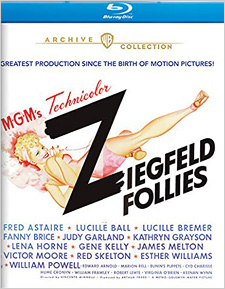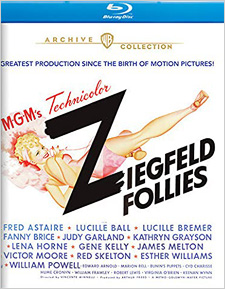Ziegfeld Follies (Blu-ray Review)

Director
VariousRelease Date(s)
1945 (June 15, 2021)Studio(s)
Metro-Goldwyn-Mayer (Warner Archive Collection)- Film/Program Grade: B
- Video Grade: A
- Audio Grade: A
- Extras Grade: A
Review
Musical revues became popular in the theater and later in early sound films. Studios eager to sell the new-fangled talkies put their stars in specialty numbers in films advertised as “all talking, all singing, all dancing.” Eventually, the public tired of the revue film and producers embraced traditional narratives with musical numbers interpolated at appropriate moments. For Ziegfeld Follies, MGM revived the revue form, drawing upon its extraordinary pool of talent to showcase its biggest stars.
The film opens with impresario Flo Ziegfeld (William Powell, reprising his role from 1936’s The Great Ziegfeld) looking down from Heaven, wishing he could put together one final production packed with stars and songs. This leads into Fred Astaire singing Bring on the Beautiful Girls as a carousel wedding cake of girls attired in pink with enormous headdresses, Cyd Charisse dancing on pointe, and Lucille Ball standing atop a white horse majestically recreate a Ziegfeld staging. A series of unrelated comedy and musical sequences follows.
A water ballet by Esther Williams, modest by comparison to her MGM extravaganzas, precedes a stiffly staged operatic selection by James Melton and Marion Bell. A comedy skit called Pay the Two Dollars stars Edward Arnold as a lawyer refusing to let his client Victor Moore pay a fine, resulting in the client’s landing in jail. Other comedy skits, one starring Keenan Wynn, the other Red Skelton, are long and not especially funny. A production number, The Great Lady Has an Interview, stars Judy Garland as a Greer Garson-style star of dramatic films who is being interviewed by a bevy of chorus boys, but Garland’s talent is wasted on uninspired material.
Limehouse Blues, a dramatic musical pantomime set in a stylized Chinatown, stars Fred Astaire and Lucille Bremer in Asian make-up. Astaire is shot during a robbery and imagines himself dancing with a beautiful woman he has just glimpsed briefly. We see him in a red costume, surrounded by darkness, until he reaches his beloved, they touch and the stage is flooded with light, revealing a yellow and blue set. The dancers are magnetic but the number is over-produced.
The best sequences are three other musical numbers. Lena Horne sings Love, by Ralph Blane and Hugh Martin, in a Caribbean setting. After a barroom scuffle the camera pans to Horne, who sings about how “love can be a moment’s madness… a life of sadness and pain… an endless fountain of youth” as she walks through the smoke-filled bar and seems to sing directly to the patrons. The number ends with a dazzling close-up of Horne’s radiant face.
This Heart of Mine, subtitled a dance story, features Fred Astaire as a gentleman jewel thief who preys on the guests at a formal ball. He zeroes in on the beautiful, bejeweled Lucille Bremer and, after a fantastic duet with her, steals a kiss—and her bracelet. When they’re about to part, she calmly removes her necklace and gives it to him. He is dumbfounded but soon sweeps her into his arms. The song by Harry Warren and Arthur Freed is a perfect choice for the romantic scenario and the set design spectacular. A couple of treadmills in the dance floor allow for some fancy movements.
The Babbit and the Bromide was the first time Fred Astaire and Gene Kelly danced together on screen. They would reunite for a bit of fancy footwork in That’s Entertainment, Part II. In this number, the two dancers kid each other before getting into character as a couple of fellows who run into each other at ten-year intervals and make generic small talk, not saying anything significant. The dance number is spirited and is a great opportunity to see these two giants dance together.
The film ends with Kathryn Grayson warbling Beauty as dancers swirl through massive mounds of bubbles, clouds appear on process screens, rocks glitter, and Dali-esque women pose against forced-perspective sets. It’s a garish conclusion to a film that bears the name of the showman famous for his theatrical excess.
Featuring 1080p resolution, Ziegfeld Follies is presented by the Warner Archive Collection in the aspect ratio of 1.37:1. Clarity and detail are remarkable for a 75-year-old film. The Technicolor photography is vibrant and often breathtaking, looking more spectacular than in the 2006 DVD edition. The musical sequences are the best showcase for the brilliant rainbow hues, from the glittery ball in the This Heart of Mine sequence with its red walls, white chandelier, stylized trees and a chorus of men and women in purple, pink, and red dresses, to the pink fantasy of Ziegfeld girls on a wedding cake merry-go-round in the Bring on the Beautiful Girls number. Limehouse Blues has Astaire and Bremer dressed in matching red outfits, allowing them to stand out from the yellow and muted blue of the extras’ costumes, backdrop, and props. Early in the sequence, Bremer wears a slinky yellow dress, standing out from the dimly lit streets and extras in darker tones. In an era well before TV when most feature films were in black-and-white, this bold use of color was yet another way to attract moviegoers.
Two separate English 2.0 DTS-HD Master Audio mixes are included. One is a split mono track and the other provides an authentic stereo experience. The two-channel mix is superior and makes for better enjoyment of the musical numbers. There’s very good channel separation, which enhances the music and vocals considerably. The MGM orchestra sounds glorious, and is heard at optimum fidelity on this release. The piece de resistance in terms of sound is This Heart of Mine, which mixes orchestral music, ambient crowd noise, vocals, and sound effects brilliantly. The comedy sketches feature crisp dialogue and, in the case of Fanny Brice and Red Skelton, comic accents and exaggerated speech. English SDH subtitles are an available option.
Bonus materials include the featurette Ziegfeld Follies: An Embarrassment of Riches, a vintage Crime Does Not Pay short, 2 cartoons, audio-only outtakes, and the film’s original theatrical trailer.
Ziegfeld Follies: An Embarrassment of Riches – Discussion about the film started at MGM in 1939, based on the success of The Great Ziegfeld. Recreating a revue on screen was innovative in the 1940s. Producer Arthur Freed was given carte blanche to use any of MGM’s stars. Ideas were plentiful. Judy Garland was originally scheduled for 12 segments but only did The Great Lady Has an Interview when Greer Garson didn’t like it and passed. Many planned numbers were never filmed. Kay Thompson did many arrangements to maximize what a singer or orchestra could do. An elaborate bubble finale did not work and many dancers had trouble breathing amid the bubbles. Only a bit of the sequence was used in the film’s finale, Beauty. Because the film originally ran 3 hours in preview, several numbers were cut, including numbers by Fred Astaire, Lena Horne, and Jimmy Durante. Shot in 1944, the film was finally released in 1946. It cost $3 million and grossed $5 million during its initial release.
Audio-Only Extras – These are numbers planned for the film, but never, or partially, used:
- Here’s to the Girls – Alternate take with an unused ending (Fred Astaire)
- Liza – An unused musical sequence (Avon Long & Co.)
- We Will Meet Again in Honolulu – Unused musical sequence (James Melton & Co.)
- A Cowboy’s Life – Unused musical sequence (James Melton & Co.)
- ’E Pinched Me – Partially used in Limehouse Blues sequence (Kay Thompson)
- Look at Me, I’m an Indian – Partially used in the opening puppet sequence (Fanny Brice)
- You’ve Gotta Start Each Day with a Song – Unused Pied Piper sequence (Jimmy Durante)
- Leo the Lion Speaks – Unused sequence
- There’s Beauty Everywhere – Unused finale sequence (James Melton & Co.)
- Love – Spanish language version (Lena Horne)
The Luckiest Guy in the World (A Crime Does Not Pay subject) – Barry Nelson stars as a gambler who owes money to a bookie and is desperate for money. While rifling through his wife’s belongings to search for hidden cash, he accidentally kills her. He later sends a car over a cliff after exchanging his ID with the driver. In one part, Red Skelton is heard on the radio cracking jokes. The gambler comes to an ironic end.
Cartoons – Two MGM cartoons are included:
- The Hick Chick – In this Tex Avery cartoon, a rooster, Mr. Kadoodlehopper, is smitten with a lovely chick. But a second rooster moves in and vies for her affection. When he kidnaps her and forces her to work in a laundry, Kadoodlehopper rescues her, but not before a chase, lots of sight gags, and slapstick ensue.
- Solid Serenade – Hanna-Barbera’s Tom and Jerry star. Tom brazenly breaks into a yard to serenade his girl, but Jerry is disturbed and determined to silence the cat with the help of the bulldog, Killer. Tom’s rendition of Is You Is or Is You Ain’t My Baby? is a highlight.
Theatrical Trailer – The 2 1/2-minute Ziegfeld Follies trailer features a narrator touting the achievement of gathering so many stars in one film. Brief clips are shown from various sequences. The final two credits, in bold red script, announce “Directed by Vincente Minnelli” and “Filmed in Technicolor.”
Ziegfeld Follies is a pot pourri, stuffed with every form of entertainment the studio could think of in a two-hour format. The film’s vast star power was intended to draw audiences, and it did. The comedy sketches have not aged as well as the musical sequences, which seem timeless. It’s fun to see so many stars “under one roof.” The film is both a treat for fans of musicals and a fascinating curiosity.
- Dennis Seuling

